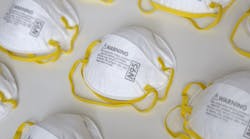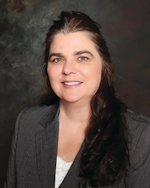As we move past the COVID-19 pandemic, it will be critical for dental providers to know what we can expect from our current personal protective equipment (PPE) so that recommendations may be made as we once again start providing services for our patients. While this is a fluid situation and may change rapidly as we learn more, current infection control guidelines provide very little direction to the dental offices for post-pandemic protocols. The first step is understanding what protection we currently have available.
Masks
There are many different types of mask used in health care and dentistry in an effort to protect workers against bacteria and viruses that may become aerosolized during dental procedures. Recalling knowledge obtained in dental and hygiene infection control courses, we know that particles smaller than 50 microns in diameter are known as aerosols. Smaller particles of an aerosol .5–10 microns can penetrate and lodge in smaller passages of the lungs, causing an infection.1
Ultrasonic scaling, crown preps, oral surgery procedures, and periodontal surgeries are known to produce aerosols that can linger in an operatory for 10 to 30 minutes following the procedure. In a 2014 study, maximum aerosol contamination was found in the assistant’s zone, followed by the operator’s zone.2
All masks are not equal and should be selected based on the design, fit, and filtration needed for each procedure or risk level. Surgical medical masks are considered medical devices and are regulated by the Food and Drug Administration (FDA). All medical masks will carry a classification from the American Society of Testing and Materials (ATSM). The ASTM is an international standards organization that develops and publishes technical standards for a wide range of products and services. In the United States, the FDA recognizes the ASTM standards for masks. Masks are graded based on their performance in five criteria: Bacterial Filtration Efficiency (BFE), Particulate Filtration Efficiency (PFE), Fluid Resistance, Differential Pressure (Delta P), and Flame Spread (table 1).
Table 1: ATSM performance criteria for grading masks3
Criteria | Description |
| Bacterial Filtration Efficiency (BFP) |
|
Particulate Filtration Efficiency (PFE) |
|
Fluid Resistance |
|
Differential Pressure (Delta P) |
|
Flame Spread |
|
It is critical to understand that a surgical mask is designed for use in an operating room or similar sterile area to protect the patient and environment from possible contamination. Furthermore, it protects the health-care provider from contaminated bodily fluids or debris that are generated when procedures are performed. Surgical masks have ties that allow adjustment for fit over surgical caps. A procedural mask is designed for use when performing patient procedures or when a patient is in isolation to protect the patient from contaminants. Procedure masks protect both the patient and health-care provider from transferring respiratory secretions, bodily fluids, or other potentially infectious material. Procedure masks have ear loops rather than ties.
ASTM performance metrics and levels3
| Test | ASTM Level 1 | ASTM Level 2 | ASTM Level 3 |
Fluid Resistance | 80 mmHg | 120 mmHg | 160 mmHg |
| Filtration – BFE | > 95% | > 98% | > 98% |
| Filtration - PFE | > 95% @ 0.1 µg | > 98% @ 0.1 µg | > 98% @ 0.1 µg |
| Delta P - Breathability | < 4.0 mm H2O/cm3 | < 5.0 mm H2O/cm3 | < 5.0 mm H2O/cm3 |
Flame Spread | Class 1 | Class 1 | Class 1 |
Respirators
How are respirators different from surgical and procedural masks? A respirator is a specific type mask that is designed to reduce the wearer’s risk of inhaling hazardous airborne particles such as dust particles or infectious agents, including gas or vapors. They may be used in manufacturing industries and in health-care applications. A respirator may cover the entire head, or it may cover the nose and mouth. Respirators require certification from the National Institute for Occupational Safety and Health (NIOSH) and prior to use a written safety standard using the Occupation Safety and Health Administration (OSHA) guidelines must be in place. Fit testing and annual training in the use, maintenance, and care are required prior to respirator use. Some respirators are disposable while others are reusable with disposable filters. Respirators should be used when engineering and work practice controls cannot prevent possible exposure or contamination.4
Understanding NIOSH classifications is critical to utilizing the appropriate mask for the job or procedure. First, respirators are rated for protection against oils, using an N (not resistant), R (somewhat resistant), and P (strongly resistant). Second, the respirators are rated by the percentage of airborne particles that are filtered in testing when using the most penetrating particle size. A respirator that filters 95% is given a rating of 95, one that filters at least 99% of the particles is given a 99, while those that filter 99.7% of the particles are given a 100.5
9 approved NIOSH respirator classes
| Family of protection | 95 | 99 | 100 |
Not resistant to oil (N) | N-95 | N-99 | N-100 |
Some resistance to oil (R) | R-95 | R-99 | R-100 |
| Strong resistance to oil (P) | P-95 | P-99 | P-100 |
Proper wear of PPE is critical
Under the OSHA Bloodborne Pathogen Standard (29 CFR 1910.1030), employers are required to protect employees who are occupationally exposed to blood or other potentially infectious materials (OPIM). The PPE must be provided by the employer and must be appropriate for the task, which means that it should fit properly and provide protection for the type of exposure expected.6 Wearing appropriate PPE properly reduces the risk of exposure. Employees should make sure that the mask is worn tightly against the face to close any gaps along the periphery of the mask.
Likewise, a mask should never be removed or worn below the chin or pulled onto the head. In doing so, it places the interior portion of the mask onto surfaces that have the potential to be contaminated with pathogens from the air. When the wearer places the mask back onto their face, covering their mouth, the wearer is now exposed to the pathogen. Furthermore, make-up, body oils, and lotions containing oil can reduce the effectiveness of an N-95 if worn improperly. Replacement should occur when wet or soiled, a new mask with every patient (unless you are using a multiuse respirator), or if you must remove your mask for any reason while treating a patient. If worn improperly, it is irrelevant what type protective mask you were wearing, as you have compromised your health.
References
- Harrel SK, Molinari J. Aerosols and splatter in dentistry: a brief review of the literature and infection control implications. J Am Dent Assoc. 2004;135(4):429–437. doi:10.14219/jada.archive.2004.0207
- Veena HR, Mahantesha S, Joseph PA, Patil SR, Patil SH. Dissemination of aerosol and splatter during ultrasonic scaling: a pilot study. J Infect Public Health. 2015;8(3):260–265. doi:10.1016/j.jiph.2014.11.004
- American Society of Testing and Materials International. ASTM F2100-19, Standard Specification for Performance of Materials Used in Medical Face Masks. ASTM International; 2019.
- Respiratory Protection. United States Department of Labor Occupational Safety and Health Administration. https://osha.gov/SLTC/respiratoryprotection/
- Respirator Fact Sheet. The National Personal Protective Technology Laboratory (NPPTL). Centers for Disease Control and Prevention. https://cdc.gov/niosh/npptl/topics/respirators/factsheets/respsars.html
- OSHA Fact Sheet. Personal Protective Equipment (PPE) Reduces Exposure to Bloodborne Pathogens. https://www.osha.gov/OshDoc/data_BloodborneFacts/bbfact03.pdf
Lori Gordon Hendrick, MS, RDH, CDA, CDT, is a dental office infection control consultant. She practices clinical hygiene and functions as office manager in a busy private practice in North Carolina. She also owns and operates Athena Dental Solutions LLC, a dental lab and consulting business. She has personal experience in developing and training dental office staff in OSHA, infection control, and HIPAA. Throughout her career in dentistry, she has experienced two OSHA inspections without any fines or penalties. She may be reached at [email protected].







